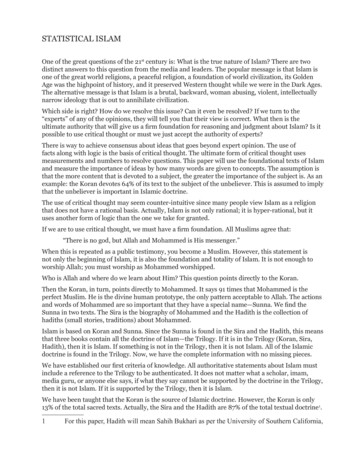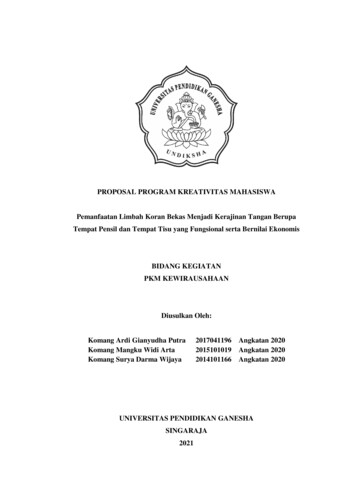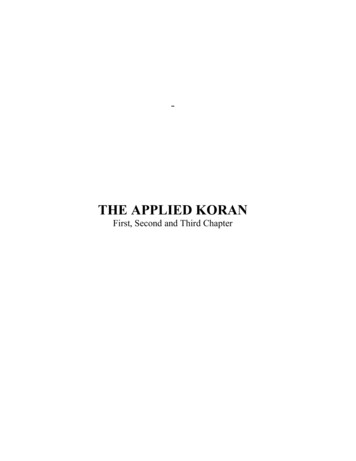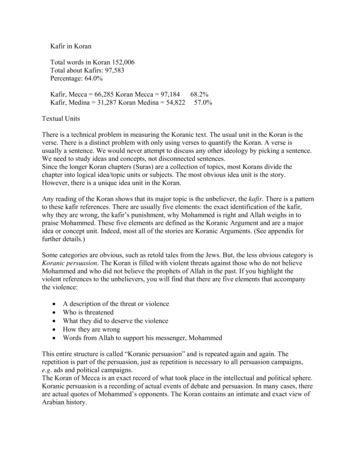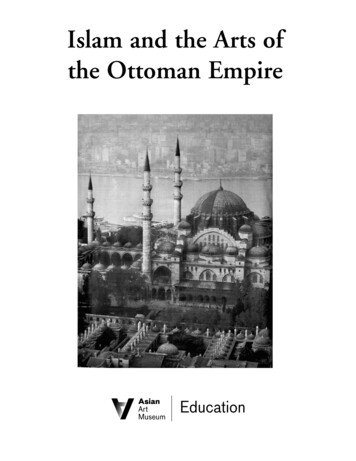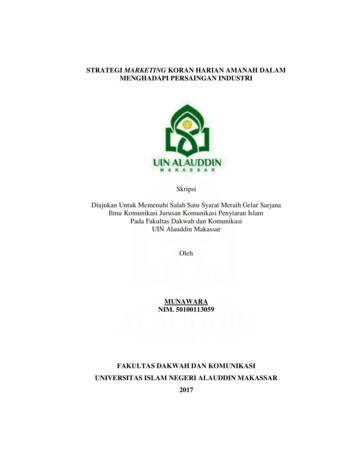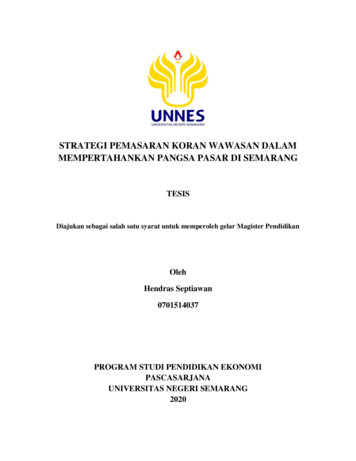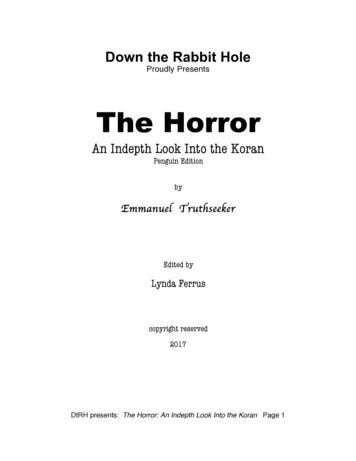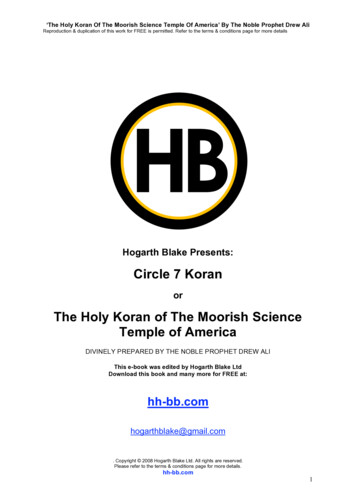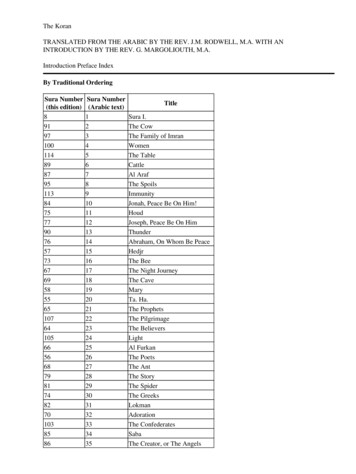
Transcription
The KoranTRANSLATED FROM THE ARABIC BY THE REV. J.M. RODWELL, M.A. WITH ANINTRODUCTION BY THE REV. G. MARGOLIOUTH, M.A.Introduction Preface IndexBy Traditional OrderingSura Number(this 651076410566566879817482701038586Sura Number(Arabic 2829303132333435TitleSura I.The CowThe Family of ImranWomenThe TableCattleAl ArafThe SpoilsImmunityJonah, Peace Be On Him!HoudJoseph, Peace Be On HimThunderAbraham, On Whom Be PeaceHedjrThe BeeThe Night JourneyThe CaveMaryTa. Ha.The ProphetsThe PilgrimageThe BelieversLightAl FurkanThe PoetsThe AntThe StoryThe SpiderThe GreeksLokmanAdorationThe ConfederatesSabaThe Creator, or The Angels
64656667686970717273747576777879Ya. SinThe RanksSadThe TroopsThe BelieverThe Made PlainCounselOrnaments of GoldSmokeThe KneelingAl AhkafMuhammadThe VictoryThe ApartmentsKafThe ScatteringThe MountainThe StarThe MoonThe MercifulThe InevitableIronShe Who PleadedThe EmigrationShe Who Is TriedBattle ArrayThe AssemblyThe HypocritesMutual DeceitDivorceThe ForbiddingThe KingdomThe PenThe InevitableThe Steps or AscentsNoahDjinnThe EnfoldedThe EnwrappedThe ResurrectionManThe SentThe NewsThose Who Drag Forth
He FrownedThe Folded UpThe CleavingThose Who StintThe Splitting AsunderThe StarryThe Night-ComerThe Most HighThe OvershadowingThe DaybreakThe SoilThe SunThe NightThe BrightnessThe OpeningThe FigThick Blood or Clots of BloodPowerClear EvidenceThe EarthquakeThe ChargersThe BlowDesireThe AfternoonThe BackbiterThe ElephantThe KoreischReligionThe AbundanceUnbelieversHELPAbu LahabThe UnityThe DaybreakMenBy Rodwell OrderingSura Number(Arabic text)9674Sura NumberTitle(this edition)1Thick Blood or Clots of Blood2The Enwrapped
31323334353637383940414243444546The EnfoldedThe BrightnessThe OpeningThe DaybreakMenSura I.UnbelieversThe UnityAbu LahabThe AbundanceThe BackbiterReligionDesireThe NightThe PenThe SoilThe ElephantThe KoreischPowerThe Night-ComerThe SunHe FrownedThe Most HighThe FigThe AfternoonThe StarryThe BlowThe EarthquakeThe CleavingThe Folded UpThe Splitting AsunderThe ChargersThose Who Drag ForthThe SentThe NewsThe OvershadowingThe DaybreakThe ResurrectionThose Who StintThe InevitableThe ScatteringThe MountainThe InevitableThe Star
798081828384858687888990The Steps or AscentsThe MercifulThe MoonThe RanksNoahManSmokeKafTa. Ha.The PoetsHedjrMarySadYa. SinOrnaments of GoldDjinnThe KingdomThe BelieversThe ProphetsAl FurkanThe Night JourneyThe AntThe CaveAdorationThe Made PlainThe KneelingThe BeeThe GreeksHoudAbraham, On Whom Be PeaceJoseph, Peace Be On HimThe BelieverThe StoryThe TroopsThe SpiderLokmanCounselJonah, Peace Be On Him!SabaThe Creator, or The AngelsAl ArafAl AhkafCattleThunder
113114The CowClear EvidenceMutual DeceitThe AssemblyThe SpoilsMuhammadThe Family of ImranBattle ArrayIronWomenDivorceThe EmigrationThe ConfederatesThe HypocritesLightShe Who PleadedThe PilgrimageThe VictoryThe ForbiddingShe Who Is TriedHELPThe ApartmentsImmunityThe TableMOHAMMED was born at Mecca in A.D. 567 or 569. His flight (hijra) to Medina, which marks thebeginning of the Mohammedan era, took place on 16th June 622. He died on 7th June 632.INTRODUCTIONTHE Koran admittedly occupies an important position among the great religious books of the world. Thoughthe youngest of the epoch-making works belonging to this class of literature, it yields to hardly any in thewonderful effect which it has produced on large masses of men. It has created an all but new phase of humanthought and a fresh type of character. It first transformed a number of heterogeneous desert tribes of theArabian peninsula into a nation of heroes, and then proceeded to create the vast politico-religiousorganisations of the Muhammedan world which are one of the great forces with which Europe and the Easthave to reckon to-day.The secret of the power exercised by the book, of course, lay in the mind which produced it. It was, in fact, atfirst not a book, but a strong living voice, a kind of wild authoritative proclamation, a series of admonitions,promises, threats, and instructions addressed to turbulent and largely hostile assemblies of untutored Arabs.As a book it was published after the prophet's death. In Muhammed's life-time there were only disjointednotes, speeches, and the retentive memories of those who listened to them. To speak of the Koran is,therefore, practically the same as speaking of Muhammed, and in trying to appraise the religious value of the
book one is at the same time attempting to form an opinion of the prophet himself. It would indeed be difficultto find another case in which there is such a complete identity between the literary work and the mind of theman who produced it.That widely different estimates have been formed of Muhammed is well-known. To Moslems he is, of course,the prophet par excellence, and the Koran is regarded by the orthodox as nothing less than the eternalutterance of Allah. The eulogy pronounced by Carlyle on Muhammed in Heroes and Hero Worship willprobably be endorsed by not a few at the present day. The extreme contrary opinion, which in a fresh form hasrecently been revived1 by an able writer, is hardly likely to find much lasting support. The correct view veryprobably lies between the two extremes. The relative value of any given system of religious thought mustdepend on the amount of truth which it embodies as well as on the ethical standard which its adherents arebidden to follow. Another important test is the degree of originality that is to be assigned to it, for it canmanifestly only claim credit for that which is new in it, not for that which it borrowed from other systems.With regard to the first-named criterion, there is a growing opinion among students of religious history thatMuhammed may in a real sense be regarded as a prophet of certain truths, though by no means of truth in theabsolute meaning of the term. The shortcomings of the moral teaching contained in the Koran are strikingenough if judged from the highest ethical standpoint with which we are acquainted; but a much morefavourable view is arrived at if a comparison is made between the ethics of the Koran and the moral tenets ofArabian and other forms of heathenism which it supplanted.The method followed by Muhammed in the promulgation of the Koran also requires to be treated withdiscrimination. From the first flash of prophetic inspiration which is clearly discernible in the earlier portionsof the book he, later on, frequently descended to deliberate invention and artful rhetoric. He, in fact,accommodated his moral sense to the circumstances in which the r\oc\le he had to play involved him.On the question of originality there can hardly be two opinions now that the Koran has been thoroughlycompared with the Christian and Jewish traditions of the time; and it is, besides some original Arabianlegends, to those only that the book stands in any close relationship. The matter is for the most part borrowed,but the manner is all the prophet's own. This is emphatically a case in which originality consists not so muchin the creation of new materials of thought as in the manner in which existing traditions of various kinds areutilised and freshly blended to suit the special exigencies of the occasion. Biblical reminiscences, Rabbiniclegends, Christian traditions mostly drawn from distorted apocryphal sources, and native heathen stories, allfirst pass through the prophet's fervid mind, and thence issue in strange new forms, tinged with poetry andenthusiasm, and well adapted to enforce his own view of life and duty, to serve as an encouragement to hisfaithful adherents, and to strike terror into the hearts of his opponents.There is, however, apart from its religious value, a more general view from which the book should beconsidered. The Koran enjoys the distinction of having been the starting-point of a new literary andphilosophical movement which has powerfully affected the finest and most cultivated minds among both Jewsand Christians in the Middle Ages. This general progress of the Muhammedan world has somehow beenarrested, but research has shown that what European scholars knew of Greek philosophy, of mathematics,astronomy, and like sciences, for several centuries before the Renaissance, was, roughly speaking, all derivedfrom Latin treatises ultimately based on Arabic originals; and it was the Koran which, though indirectly, gavethe first impetus to these studies among the Arabs and their allies. Linguistic investigations, poetry, and otherbranches of literature, also made their appearance soon after or simultaneously with the publication of theKoran; and the literary movement thus initiated has resulted in some of the finest products of genius andlearning.The style in which the Koran is written requires some special attention in this introduction. The literary formis for the most part different from anything else we know. In its finest passages we indeed seem to hear avoice akin to that of the ancient Hebrew prophets, but there is much in the book which Europeans usuallyregard as faulty. The tendency to repetition which is an inherent characteristic of the Semitic mind appearshere in an exaggerated form, and there is in addition much in the Koran which strikes us as wild and fantastic.
The most unfavourable criticism ever passed on Muhammed's style has in fact been penned by the prophet'sgreatest British admirer, Carlyle himself; and there are probably many now who find themselves in the samedilemma with that great writer.The fault appears, however, to lie partly in our difficulty to appreciate the psychology of the Arab prophet.We must, in order to do him justice, give full consideration to his temperament and to the condition of thingsaround him. We are here in touch with an untutored but fervent mind, trying to realise itself and to assimilatecertain great truths which have been powerfully borne in upon him, in order to impart them in a convincingform to his fellow-tribesmen. He is surrounded by obstacles of every kind, yet he manfully struggles on withthe message that is within him. Learning he has none, or next to none. His chief objects of knowledge arefloating stories and traditions largely picked up from hearsay, and his over-wrought mind is his only teacher.The literary compositions to which he had ever listened were the half-cultured, yet often wildly powerfulrhapsodies of early Arabian minstrels, akin to Ossian rather than to anything else within our knowledge. Whatwonder then that his Koran took a form which to our colder temperaments sounds strange, unbalanced, andfantastic?Yet the Moslems themselves consider the book the finest that ever appeared among men. They find noincongruity in the style. To them the matter is all true and the manner all perfect. Their eastern temperamentresponds readily to the crude, strong, and wild appeal which its cadences make to them, and the jinglingrhyme in which the sentences of a discourse generally end adds to the charm of the whole. The Koran, even ifviewed from the point of view of style alone, was to them from the first nothing less than a miracle, as great amiracle as ever was wrought.But to return to our own view of the case. Our difficulty in appreciating the style of the Koran evenmoderately is, of course, increased if, instead of the original, we have a translation before us. But one is happyto be able to say that Rodwell's rendering is one of the best that have as yet been produced. It seems to a greatextent to carry with it the atmosphere in which Muhammed lived, and its sentences are imbued with theflavour of the East. The quasi-verse form, with its unfettered and irregular rhythmic flow of the lines, whichhas in suitable cases been adopted, helps to bring out much of the wild charm of the Arabic. Not the leastamong its recommendations is, perhaps, that it is scholarly without being pedantic that is to say, that it aims atcorrectness without sacrificing the right effect of the whole to over-insistence on small details.Another important merit of Rodwell's edition is its chronological arrangement of the Suras or chapters. As hetells us himself in his preface, it is now in a number of cases impossible to ascertain the exact occasion onwhich a discourse, or part of a discourse, was delivered, so that the system could not be carried through withentire consistency. But the sequence adopted is in the main based on the best available historical and literaryevidence; and in following the order of the chapters as here printed, the reader will be able to trace thedevelopment of the prophet's mind as he gradually advanced from the early flush of inspiration to the lessspiritual and more equivocal r\oc\le of warrior, politician, and founder of an empire.G. Margoliouth.1Mahommed and the Rise of Islam, in Heroes of Nations series.SELECT BIBLIOGRAPHYENGLISH TRANSLATIONS. From the original Arabic by G. Sale, 1734, 1764, 1795, 1801; many latereditions, which include a memoir of the translator by R. A. Davenport, and notes from Savary's version of theKoran; an edition issued by E. M. Wherry, with additional notes and commentary (Tr\du\ubner's OrientalSeries), 1882, etc.; Sale's translation has also been edited in the Chandos Classics, and among Lubbock'sHundred Books (No. 22). The Holy Qur\da\an, translated by Dr. Mohammad Abdul Hakim Khan, with shortnotes, 1905; Translation by J. M. Rodwell, with notes and index (the Suras arranged in chronological order),1861, 2nd ed., 1876; by E. H. Palmer (Sacred Books of the East, vols. vi., ix.).
SELECTIONS: Chiefly from Sale's edition, by E. W. Lane, 1843; revised and enlarged with introduction byS. Lane-Poole. (Tr\du\ubner's Oriental Series), 1879; The Speeches and Table-Talk of the ProphetMohammad, etc., chosen and translated, with introduction and notes by S. Lane-Poole, 1882 (Golden TreasurySeries); Selections with introduction and explanatory notes (from Sale and other writers), by J. Murdock(Sacred Books of the East), 2nd ed., 1902; The Religion of the Koran, selections with an introduction by A. N.Wollaston (The Wisdom of the East), 1904.See also: Sir W. Muir: The Koran, its Composition and Teaching, 1878; H. Hirschfeld: New Researchesinto the Composition and Exegesis of the Qoran, 1902; W. St C. Tisdale: Sources of the Qur ân, 1905; H. U.W. Stanton: The Teaching of the Qur án, 1919; A. Mingana: Syriac Influence on the Style of the Kur ân,1927.TOSIR WILLIAM MARTIN, K.T., D.C.L.LATE CHIEF JUSTICE OF NEW ZEALAND,THIS VOLUME IS DEDICATED,WITH SINCERE FEELINGS OF ESTEEM FOR HIS PRIVATE WORTH,PUBLIC SERVICES,AND EMINENT LITERARY ATTAINMENTS,BYTHE TRANSLATOR.PREFACEIt is necessary that some brief explanation should be given with reference to the arrangement of the Suras, orchapters, adopted in this translation of the Koran. It should be premised that their order as it stands in allArabic manuscripts, and in all hitherto printed editions, whether Arabic or European, is not chronological,neither is there any authentic tradition to shew that it rests upon the authority of Muhammad himself. Thescattered fragments of the Koran were in the first instance collected by his immediate successor Abu Bekr,about a year after the Prophet's death, at the suggestion of Omar, who foresaw that, as the Muslim warriors,whose memories were the sole depositaries of large portions of the revelations, died off or were slain, as hadbeen the case with many in the battle of Yemâma, A.H. 12, the loss of the greater part, or even of the whole,was imminent. Zaid Ibn Thâbit, a native of Medina, and one of the Ansars, or helpers, who had beenMuhammad's amanuensis, was the person fixed upon to carry out the task, and we are told that he "gatheredtogether" the fragments of the Koran from every quarter, "from date leaves and tablets of white stone, andfrom the breasts of men."1 The copy thus formed by Zaid probably remained in the possession of Abu Bekrduring the remainder of his brief caliphate, who committed it to the custody of Haphsa, one of Muhammad'swidows, and this text continued during the ten years of Omar's caliphate to be the standard. In the copies madefrom it, various readings naturally and necessarily sprung up; and these, under the caliphate of Othman, led tosuch serious disputes between the faithful, that it became necessary to interpose, and in accordance with thewarning of Hodzeifa, "to stop the people, before they should differ regarding their scriptures, as did the Jews
and Christians."2 In accordance with this advice, Othman determined to establish a text which should be thesole standard, and entrusted the redaction to the Zaid already mentioned, with whom he associated ascolleagues, three, according to others, twelve3 of the Koreisch, in order to secure the purity of that Meccanidiom in which Muhammad had spoken, should any occasions arise in which the collators might have todecide upon various readings. Copies of the text formed were thus forwarded to several of the chief militarystations in the new empire, and all previously existing copies were committed to the flames.Zaid and his coadjutors, however, do not appear to have arranged the materials which came into their handsupon any system more definite than that of placing the longest and best known Suras first, immediately afterthe Fatthah, or opening chapter (the eighth in this edition); although even this rule, artless and unscientific asit is, has not been adhered to with strictness. Anything approaching to a chronological arrangement wasentirely lost sight of. Late Medina Suras are often placed before early Meccan Suras; the short Suras at the endof the Koran are its earliest portions; while, as will be seen from the notes, verses of Meccan origin are to befound embedded in Medina Suras, and verses promulged at Medina scattered up and down in the MeccanSuras. It would seem as if Zaid had to a great extent put his materials together just as they came to hand, andoften with entire disregard to continuity of subject and uniformity of style. The text, therefore, as hithertoarranged, necessarily assumes the form of a most unreadable and incongruous patchwork; "une assemblage,"says M. Kasimirski in his Preface, "informe et incohérent de préceptes moraux, religieux, civils et politiques,mêlés d'exhortations, de promesses, et de menaces" and conveys no idea whatever of the development andgrowth of any plan in the mind of the founder of Islam, or of the circumstances by which he was surroundedand influenced. It is true that the manner in which Zaid contented himself with simply bringing together hismaterials and transcribing them, without any attempt to mould them into shape or sequence, and without anyeffort to supply connecting links between adjacent verses, to fill up obvious chasms, or to suppress details of anature discreditable to the founder of Islam, proves his scrupulous honesty as a compiler, as well as hisreverence for the sacred text, and to a certain extent guarantees the genuineness and authenticity of the entirevolume. But it is deeply to be regretted that he did not combine some measure of historical criticism with thatsimplicity and honesty of purpose which forbade him, as it certainly did, in any way to tamper with the sacredtext, to suppress contradictory, and exclude or soften down inaccurate, statements.The arrangement of the Suras in this translation is based partly upon the traditions of the Muhammadansthemselves, with reference especially to the ancient chronological list printed by Weil in his Mohammed derProphet, as well as upon a careful consideration of the subject matter of each separate Sura and its probableconnection with the sequence of events in the life of Muhammad. Great attention has been paid to this subjectby Dr. Weil in the work just mentioned; by Mr. Muir in his Life of Mahomet, who also publishes achronological list of Suras, 21 however of which he admits have "not yet been carefully fixed;" and especiallyby Nöldeke, in his Geschichte des Qôrans, a work to which public honours were awarded in 1859 by the ParisAcademy of Inscriptions. From the arrangement of this author I see no reason to depart in regard to the laterSuras. It is based upon a searching criticism and minute analysis of the component verses of each, and may besafely taken as a standard, which ought not to be departed from without weighty reasons. I have, however,placed the earlier and more fragmentary Suras, after the two first, in an order which has reference rather totheir subject matter than to points of historical allusion, which in these Suras are very few; whilst on the otherhand, they are mainly couched in the language of self-communion, of aspirations after truth, and of mentalstruggle, are vivid pictures of Heaven and Hell, or descriptions of natural objects, and refer also largely to theopposition met with by Muhammad from his townsmen of Mecca at the outset of his public career. Thisremark applies to what Nöldeke terms "the Suras of the First Period."The contrast between the earlier, middle, and later Suras is very striking and interesting, and will be at onceapparent from the arrangement here adopted. In the Suras as far as the 54th, p. 76, we cannot but notice theentire predominance of the poetical element, a deep appreciation (as in Sura xci. p. 38) of the beauty of naturalobjects, brief fragmentary and impassioned utterances, denunciations of woe and punishment, expressed forthe most part in lines of extreme brevity. With a change, however, in the position of Muhammad when heopenly assumes the office of "public warner," the Suras begin to assume a more prosaic and didactic tone,though the poetical ornament of rhyme is preserved throughout. We gradually lose the Poet in the missionaryaiming to convert, the warm asserter of dogmatic truths; the descriptions of natural objects, of the judgment,
of Heaven and Hell, make way for gradually increasing historical statements, first from Jewish, andsubsequently from Christian histories; while, in the 29 Suras revealed at Medina, we no longer listen to vaguewords, often as it would seem without positive aim, but to the earnest disputant with the enemies of his faith,the Apostle pleading the cause of what he believes to be the Truth of God. He who at Mecca is the admonisherand persuader, at Medina is the legislator and the warrior, who dictates obedience, and uses other weaponsthan the pen of the Poet and the Scribe. When business pressed, as at Medina, Poetry makes way for Prose,and although touches of the Poetical element occasionally break forth, and he has to defend himself up to avery late period against the charge of being merely a Poet, yet this is rarely the case in the Medina Suras; andwe are startled by finding obedience to God and the Apostle, God's gifts and the Apostle's, God's pleasure andthe Apostle's, spoken of in the same breath, and epithets and attributes elsewhere applied to Allah openlyapplied to himself as in Sura ix., 118, 129.The Suras, viewed as a whole, strike me as being the work of one who began his career as a thoughtfulenquirer after truth, and an earnest asserter of it in such rhetorical and poetical forms as he deemed most likelyto win and attract his countrymen, and who gradually proceeded from the dogmatic teacher to the politicfounder of a system for which laws and regulations had to be provided as occasions arose. And of all theSuras it must be remarked that they were intended not for readers but for hearers that they were allpromulgated by public recital and that much was left, as the imperfect sentences shew, to the manner andsuggestive action of the reciter. It would be impossible, and indeed it is unnecessary, to attempt a detailed lifeof Muhammad within the narrow limits of a Preface. The main events thereof with which the Suras of theKoran stand in connection, are The visions of Gabriel, seen, or said to have been seen, at the outset of hiscareer in his 40th year, during one of his seasons of annual monthly retirement, for devotion and meditation toMount Hirâ, near Mecca, the period of mental depression and re-assurance previous to the assumption of theoffice of public teacher the Fatrah or pause (see n. p. 20) during which he probably waited for a repetition ofthe angelic vision his labours in comparative privacy for three years, issuing in about 40 converts, of whomhis wife Chadijah was the first, and Abu Bekr the most important: (for it is to him and to Abu Jahl the Suraxcii. p. 32, refers) struggles with Meccan unbelief and idolatry followed by a period during which probablyhe had the second vision, Sura liii. p. 69, and was listened to and respected as a person "possessed" (Sura lxix.42, p. 60, lii. 29, p. 64) the first emigration to Abyssinia in A.D. 616, in consequence of the Meccanpersecutions brought on by his now open attacks upon idolatry (Taghout) increasing reference to Jewish andChristian histories, shewing that much time had been devoted to their study the conversion of Omar in617 the journey to the Thaquifites at Taief in A.D. 620 the intercourse with pilgrims from Medina, whobelieved in Islam, and spread the knowledge thereof in their native town, in the same year the vision of themidnight journey to Jerusalem and the Heavens the meetings by night at Acaba, a mountain near Mecca, inthe 11th year of his mission, and the pledges of fealty there given to him the command given to the believersto emigrate to Yathrib, henceforth Medinat-en-nabi (the city of the Prophet) or El-Medina (the city), in Aprilof A.D. 622 the escape of Muhammad and Abu Bekr from Mecca to the cave of Thaur the FLIGHT toMedina in June 20, A.D. 622 treaties made with Christian tribes increasing, but still very imperfectacquaintance with Christian doctrines the Battle of Bedr in Hej. 2, and of Ohod the coalition formed againstMuhammad by the Jews and idolatrous Arabians, issuing in the siege of Medina, Hej. 5 (A.D. 627) theconvention, with reference to the liberty of making the pilgrimage, of Hudaibiya, Hej. 6 the embassy toChosroes King of Persia in the same year, to the Governor of Egypt and to the King of Abyssinia, desiringthem to embrace Islam the conquest of several Jewish tribes, the most important of which was that of Chaibarin Hej. 7, a year marked by the embassy sent to Heraclius, then in Syria, on his return from the Persiancampaign, and by a solemn and peaceful pilgrimage to Mecca the triumphant entry into Mecca in Hej. 8(A.D. 630), and the demolition of the idols of the Caaba the submission of the Christians of Nedjran, of Ailaon the Red Sea, and of Taief, etc., in Hej. 9, called "the year of embassies or deputations," from the numerousdeputations which flocked to Mecca proffering submission and lastly in Hej. 10, the submission ofHadramont, Yemen, the greater part of the southern and eastern provinces of Arabia and the final solemnpilgrimage to Mecca.While, however, there is no great difficulty in ascertaining the Suras which stand in connection with the moresalient features of Muhammad's life, it is a much more arduous, and often impracticable task, to point out theprecise events to which individual verses refer, and out of which they sprung. It is quite possible that
Muhammad himself, in a later period of his career, designedly mixed up later with earlier revelations in thesame Suras not for the sake of producing that mysterious style which seems so pleasing to the mind of thosewho value truth least when it is most clear and obvious but for the purpose of softening down some of theearlier statements which represent the last hour and awful judgment as imminent; and thus leading hisfollowers to continue still in the attitude of expectation, and to see in his later successes the truth of his earlierpredictions. If after-thoughts of this kind are to be traced, and they will often strike the attentive reader, it thenfollows that the perplexed state of the text in individual Suras is to be considered as due to Muhammadhimself, and we are furnished with a series of constant hints for attaining to chronological accuracy. And itmay be remarked in passing, that a belief that the end of all things was at hand, may have tended to promotethe earlier successes of Islam at Mecca, as it unquestionably was an argument with the Apostles, to flee from"the wrath to come." It must be borne in mind that the allusions to contemporary minor events, and to thelocal efforts made by the new religion to gain the ascendant are very few, and often couched in terms so vagueand general, that we are forced to interpret the Koran solely by the Koran itself. And for this, the frequentrepetitions of the same histories and the same sentiments, afford much facility: and the peculiar manner inwhich the details of each history are increased by fresh traits at each recurrence, enables us to trace theirgrowth in the author's mind, and to ascertain the manner in which a part of the Koran was composed. Theabsence of the historical element from the Koran as regards the details of Muhammad's daily life, may bejudged of by the fact, that only two of his contemporaries are mentioned in the entire volume, and thatMuhammad's name occurs but five time
The Koran TRANSLATED FROM THE ARABIC BY THE REV. J.M. RODWELL, M.A. WITH AN INTRODUCTION BY THE REV. G. MARGOLIOUTH, M.A. Introduction Preface Index By Traditional Ordering Sura Number (this edition) Sura Number (Arabic text) Title 8 1 Sura I. 91 2 The Cow 97 3 The Family of Imran 10

